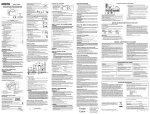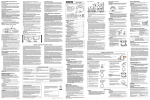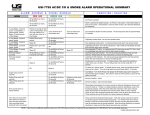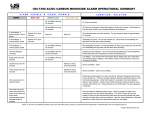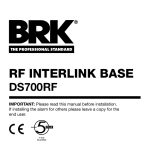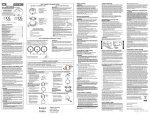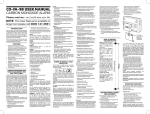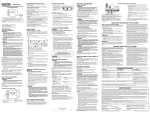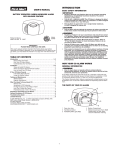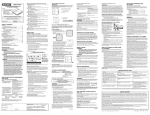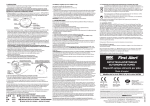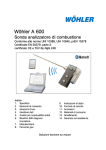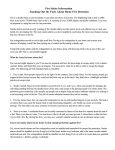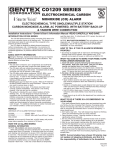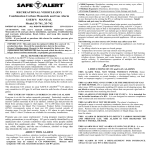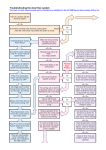Transcript
UNDERSTANDING YOUR CO ALARM WELCOME CHIRP Horn chirps and light blinks once when batteries are first connected. USER’S MANUAL BATTERY OPERATED CARBON MONOXIDE ALARM WITH SILENCE FEATURE ALARM RECEIVING BATTERY POWER Green light flashes every minute. Horn is silent. LOW BATTERY WARNING Audible warning only. The horn “chirps” once every minute. This warning should last for up to 30 days, but you should replace the batteries as soon as possible. DURING TESTING Light flashes Red in sync with the horn pattern (4 beeps, pause, 4 beeps), simulating a CO Alarm condition. BS EN 50291:2001 Licence No: KM554921 M09-0058-008 P 09/09 Model CO400 CO4000 CO ALARM Sensor has detected enough CO to trigger an alarm. Light flashes rapidly and horn sounds loudly (repeating 4 beeps, pause). See “If Your CO Alarm Sounds” for details. During an alarm, move everyone to a source of fresh air. DO NOT move the CO Alarm! This user’s manual contains important information about your Carbon Monoxide (CO) Alarm’s operation. If you are installing this CO Alarm for use by others, you must leave this manual—or a copy of it—with the end user. © 2009 BRK Brands Europe Ltd Unit 6, Carter Court, Davy Way, Waterwells Business Park Quedgeley, Gloucester GL2 2DE United Kingdom All rights reserved. E-mail address: [email protected] • [email protected] www.firstalert.eu • www.brkdicon.eu WHAT TO DO IF THE ALARM SOUNDS The light flashes (RED) and the horn sounds 3 “chirps” every minute. CO Alarm needs to be replaced. CO ALARM HAS REACHED ITS END OF LIFE If the alarm sounds, respond as follows: The light flashes (RED) and the horn sounds 5 “chirps” every minute. CO Alarm needs to be replaced. 1. If anyone is experiencing the effects of carbon monoxide poisoning–headache, dizziness, nausea or other ‘flu-like’ symptoms:– 2. Open the doors and windows to ventilate. 3. Turn off any fuel-burning appliances where possible and stop using them. 4. Evacuate the property leaving the doors and windows open. 5. Ring your gas or other fuel supplier on their emergency number. Record those numbers here:– TABLE OF CONTENTS Introduction . . . . . . . . . . . . . . . . . . . . . . . . . . . . . . . . . . . . . . . . . . . . . . . . . .1-2 Basic Safety Information . . . . . . . . . . . . . . . . . . . . . . . . . . . . . . . . . . . . .1 How Your CO Alarm Works . . . . . . . . . . . . . . . . . . . . . . . . . . . . . . . . . . .1 Understanding Your CO Alarm . . . . . . . . . . . . . . . . . . . . . . . . . . . . . . . . .2 Installation . . . . . . . . . . . . . . . . . . . . . . . . . . . . . . . . . . . . . . . . . . . . . . . . . . .2-3 Where to and Where Not to Install CO Alarms . . . . . . . . . . . . . . . . . . . .2 How to Install Your CO Alarm . . . . . . . . . . . . . . . . . . . . . . . . . . . . . . . .2-3 What to Do if the Alarm Sounds . . . . . . . . . . . . . . . . . . . . . . . . . . . . . . . . . .3 Using the Silence Feature . . . . . . . . . . . . . . . . . . . . . . . . . . . . . . . . . . . .3 Testing and Maintenance . . . . . . . . . . . . . . . . . . . . . . . . . . . . . . . . . . . . . .3-4 Weekly Testing . . . . . . . . . . . . . . . . . . . . . . . . . . . . . . . . . . . . . . . . . . . . .3 Regular Maintenance . . . . . . . . . . . . . . . . . . . . . . . . . . . . . . . . . . . . . . . .4 What You Need To Know About CO . . . . . . . . . . . . . . . . . . . . . . . . . . . . . .4-6 What is CO? . . . . . . . . . . . . . . . . . . . . . . . . . . . . . . . . . . . . . . . . . . . . . . .4 Symptoms of CO Poisoning . . . . . . . . . . . . . . . . . . . . . . . . . . . . . . . . . .4 Finding the Source of CO After an Alarm . . . . . . . . . . . . . . . . . . . . . . . .4 Tips for the Homeowner? . . . . . . . . . . . . . . . . . . . . . . . . . . . . . . . . . . . . .4 Additional Safety Tips . . . . . . . . . . . . . . . . . . . . . . . . . . . . . . . . . . . . . . .4 Potential Sources of CO in the Home . . . . . . . . . . . . . . . . . . . . . . . . .5-6 EN 50291:2001 . . . . . . . . . . . . . . . . . . . . . . . . . . . . . . . . . . . . . . . . . . . . . . . .5-6 General Limitations Of CO Alarms . . . . . . . . . . . . . . . . . . . . . . . . . . . . . .5-6 Troubleshooting Guide . . . . . . . . . . . . . . . . . . . . . . . . . . . . . . . . . . . . . . . .5-6 Limited Guarantee . . . . . . . . . . . . . . . . . . . . . . . . . . . . . . . . . . . . . . . . . . .5-6 INSTALLATION WHERE TO AND WHERE NOT TO INSTALL CO ALARMS Ideally, you should have an alarm in or near every room that has a fuelburning appliance. However, if you have more than one appliance, but only one alarm, you should take the following into consideration when deciding where best to put the alarm. • • • • If there is a fuel-burning appliance in the room where you sleep, you should put the alarm in that room. If there is a fuel-burning appliance in the room that you use a lot, e.g. a sitting room, you should put it in that room. If you live in a bed-sit put the alarm as far away from the cooking appliances as possible, but near to the place where you sleep. If the fuel-burning appliance is in a room not normally used (e.g. a boiler room) put the alarm just outside the room so that you will be able to hear the alarm more easily. If the alarm is in the same room as the appliance: – It should be mounted on or close to the ceiling at a height greater than that of any door or window. It should be at least 300mm from any wall, light fitting or any other obstruction. If mounted on a wall it should be at least 150mm from the ceiling. If mounted in a room with a sloped or gabled ceiling it should be at least 1 metre lower than the highest point of the room as long as that is above doors and windows. If the alarm is in a room that is remote from the appliance, then the alarm should be in the breathing zone of the occupants. • An alarm should be at least 1.8 metres (6 feet) from the fuel-burning appliance. Gas supplier :- ____________________________ CAPITA Engineer :- _____________________________ Hospital/Doctor :- ____________________________ • • • Bedroom Garage THIS IS NOT A SMOKE ALARM! This CO Alarm is designed to detect carbon monoxide from ANY source of combustion. It is NOT designed to detect smoke, fire, or any other gas. This CO Alarm is approved for use in single-family residences. It is NOT designed for marine use or for use in a caravan. Carbon Monoxide Alarms NEVER ignore your Carbon Monoxide Alarm if it alarms. Refer to “If Your CO Alarm Sounds” for more information. Failure to do so can result in injury or death. • Test the CO Alarm once a week. If the CO Alarm ever fails to test correctly, have it replaced immediately! If the CO Alarm is not working properly, it cannot alert you to a problem. • • • • • GENERAL INFORMATION • This CO Alarm does not operate without working batteries. Removing the batteries, or failure to replace them at the end of their service life, removes your protection. A CO Alarm measures the CO levels in the air. It will alarm if CO levels rise quickly (if the heat exchanger on your furnace breaks, for example), or if CO is consistently present (a slow CO leak on a fuel-burning appliance). This Carbon Monoxide Alarm features a permanently installed sensor and an 85 dB alarm horn. It also has a silence feature to temporarily quiet the alarm horn. THE PARTS OF YOUR CO ALARM 2 1 • • • not put a CO alarm: Outside the building. In close proximity to a vehicle exhaust pipe; this will damage the alarm. In or below a cupboard. In a damp or humid area. Near paint thinners, adhesives, polishes, aerosols, or household cleaning products. Other substances may also affect the reliability of the unit. Directly above a sink or cooker. Next to a door window or extractor fan or anywhere that it would be affected by draughts. In exhaust streams from gas engines, vents, flues or chimneys. Where it would be obstructed by curtains or furniture. In an area where the temperature could drop below -10º C or rise to above 40º C. Where humidity is less than 30% R.H. or more than 90% R.H. Where dirt or dust could block the sensor and stop it from working. Where it could be easily knocked or damaged, or where it could be accidentally turned off or removed. • This CO Alarm is designed for use inside a single-family home or apartment. It is not meant to be used in common lobbies, hallways, or basements of multi-family buildings unless working CO Alarms are also installed in each family living unit. CO Alarms in common areas may not be heard from inside individual family living units. 3 4 4 Battery Compartment 5 (Behind Cover) Alarm Horn: 85dB audible alarm for test, alarm, and unit malfunction warning. 1 Open door here 2 Test/Silence Button 3 POWER/ALARM Light (RED) USING THE SILENCE FEATURE Evelyn Colon Digitally signed by Evelyn Colon Date: 2009.09.16 08:20:15 -05'00' • NEVER remove the batteries from your CO Alarm to silence the horn. Use the silence feature. Removing the batteries removes your protection! See “What to Do if the Alarm Sounds” for details on responding to an alarm. The Silence Feature is intended to temporarily silence your CO Alarm’s alarm horn while you correct the problem—it will not correct a CO problem. While the alarm is silenced it will continue to monitor the air for CO. NOTE: After initial 4-minute Silence cycle, the CO Alarm re-evaluates present CO levels and responds accordingly. If CO levels remain potentially dangerous —or start rising higher—the horn will start sounding again. If the CO Alarm... This means... Is silent for only 4 minutes, then starts sounding loudly—4 beeps, pause, 4 beeps, pause CO levels are still potentially dangerous. If the CO Alarm... This means... Remains silent after you pressed the Test/Silence button CO levels are dropping. SILENCING THE LOW BATTERY WARNING This silence feature can temporarily quiet the low battery warning “chirp” for up to 8 hours. You can silence the low battery warning “chirp” by pressing the Test/Silence button. An acknowledge “chirp” will let you know that the low battery silence feature has been activated. After 8 hours, the low battery “chirp” will resume. Replace the batteries as soon as possible; this unit will not operate without battery power! If you cannot silence the low battery warning, the batteries are too low. Replace the batteries immediately. SILENCING THE END OF LIFE SIGNAL This silence feature can temporarily quiet the End of Life warning “chirp” for up to 2 days. You can silence the End of Life warning “chirp” by pressing the Test/Silence button. The horn will chirp, acknowledging that the End of Life silence feature has been activated. • DO NOT use this CO Alarm in warehouses, industrial or commercial buildings, special-purpose non-residential buildings, or airplanes. This CO Alarm is specifically designed for residential use, and may not provide adequate protection in non-residential applications. TESTING & MAINTENANCE WEEKLY TESTING • Test the CO Alarm once a week. If the CO Alarm ever fails to test correctly, have it replaced immediately! If the CO Alarm is not working properly, it cannot alert you to a problem. • DO NOT stand close to the Alarm when the horn is sounding. Exposure at close range may be harmful to your hearing. When testing, step away when horn starts sounding. Read “Where To and Where Not to Install CO Alarms” before starting. INSTALLING THE AA BATTERIES 1. Flip the battery door down to open. 2. Install both AA batteries (included) inside the battery compartment as indicated. Make sure the “+” and “–” ends of each battery are aligned properly. A chirp will be issued. 3. Close the battery door. Household cleaners, aerosol chemicals, and other contaminants can affect the sensor. When using any of these materials near the CO Alarm, make sure the room is well ventilated. Push and hold the Test/Silence button on the cover until the LED flashes. The alarm horn will sound 4 beeps, a pause, then 4 beeps. The ALARM (RED) light will flash. The alarm sequence should last 5-6 seconds. If it does not alarm, make sure fresh batteries are correctly installed, and test it again. If the unit still does not alarm, replace it immediately. If the alarm does not test properly: 1. Make sure that fresh batteries are installed correctly. 2. Be sure the Alarm is clean and dust-free. 3. Install fresh AA batteries* and test the Alarm again. • • DO NOT try fixing the Alarm yourself – this will void your warranty! If the CO Alarm is still not operating properly, and it is still under warranty, please see "How to Obtain Warranty Service" in the Limited Warranty. Install a new CO Alarm immediately. The Test/Silence button is the only proper way to test the CO Alarm. NEVER use vehicle exhaust! Exhaust may cause permanent damage and voids your warranty. *For a list of acceptable replacement batteries, see “Regular Maintenance.” Mounting Guide Template 64 mm (2.5 inches) 2. Extended operation of unvented fuel burning devices (range, oven, fireplace). 3. Temperature inversions, which can trap exhaust close to the ground. 4. Car idling in an open or closed attached garage, or near a home. These conditions are dangerous because they can trap exhaust in your home. Since these conditions can come and go, they are also hard to recreate during a CO investigation. BRITISH STANDARD INSTITUTE EN 50291:2001 WHAT LEVELS OF CO CAUSE AN ALARM? WHAT YOU NEED TO KNOW ABOUT CO WHAT IS CO? CO is an invisible, odourless, tasteless gas produced when fossil fuels do not burn completely, or are exposed to heat (usually fire). Electrical appliances typically do not produce CO. These fuels include: Wood, coal, charcoal, oil, natural gas, gasoline, kerosene, and propane. Common appliances are often sources of CO. If they are not properly maintained, are improperly ventilated, or malfunction, CO levels can rise quickly. CO is a real danger now that homes are more energy efficient. “Air-tight” homes with added insulation, sealed windows, and other weatherproofing can “trap” CO inside. Technical information Your alarm utilizes a proprietary Electronic Sensing Technology that permits the unit to vary the exposure time before the alarm sounds based on carbon monoxide concentrations. The carbon monoxide concentrations and time standards for the alarms are as follows: Carbon Monoxide Concentration 50 ppm 100 ppm 300 ppm No alarm before Will alarm before 60 minutes 10 minutes — 90 minutes 40 minutes 3 minutes Alarms have various limitations. See "General Limitations of CO Alarms" for details. • This CO Alarm alone is not a suitable substitute for complete detection systems in places which house many people, like hotels or dormitories, unless a CO Alarm is also placed in each unit. Before you start installation, find the pair of self-adhesive labels included with this CO Alarm. On each label write in the phone number of your emergency responder (like 999 in the UK or 112 in Europe) and a qualified appliance technician. Place one label near the CO Alarm, and the other label in the “fresh air” location you plan to go if the alarm sounds. DO NOT spray cleaning chemicals or insect sprays directly on or near the CO Alarm. DO NOT paint over the CO Alarm. Doing so may cause permanent damage. Fuel-burning appliances like: portable heater, gas or wood burning fireplace, gas kitchen range or cooktop, gas clothes dryer. Damaged or insufficient venting: corroded or disconnected water heater vent pipe, leaking chimney pipe or flue, or cracked heat exchanger, blocked or clogged chimney opening. Improper use of appliance/device: operating a barbecue grill or vehicle in an enclosed area (like a garage or screened porch). Transient CO Problems: “transient” or on-again-off-again CO problems can be caused by outdoor conditions and other special circumstances. CO alarms may not waken all individuals. If children or others do not readily waken to the sound of the CO alarm, or if there are infants or family members with mobility limitations, make sure that someone is assigned to assist them in the event of an emergency. After approximately 2 days, the End of Life “chirp” will resume. After approximately 2-3 weeks the End of Life warning cannot be silenced. HOW TO INSTALL YOUR CO ALARM 5 Use only the replacement batteries listed. The unit may not operate properly with other batteries. Never use rechargeable batteries since they may not provide a constant charge. Some individuals are more sensitive to CO than others, including people with cardiac or respiratory problems, infants, unborn babies, pregnant mothers, or elderly people can be more quickly and severely affected by CO. These people should consult their doctors for advice on taking additional precautions. While the detector is silenced: • HOW YOUR CO ALARM WORKS Heat Alarms For added protection This CO Alarm will only indicate the presence of carbon monoxide gas at the sensor. Carbon monoxide gas may be present in other areas. The Silence Feature is for your convenience only and will not correct a CO problem. Always check your home for a potential problem after any alarm. Failure to do so can result in injury or death. Lounge Choosing a replacement battery: This CO Alarm requires two alkaline LR6 1.5VDC AA batteries. The following batteries are acceptable as replacements: Duracell MN1500 (LR6), Energizer E91. These replacement batteries are commonly available at local retail stores. CO Alarms are designed to alarm before there is an immediate life threat. Since you cannot see or smell CO, never assume it’s not present. • An exposure to 100 ppm of CO for 20 minutes may not affect average, healthy adults, but after 4 hours the same level may cause headaches. • An exposure to 400 ppm of CO may cause headaches in average, healthy adults after 35 minutes, but can cause death after 2 hours. When CO reaches alarm levels the alarm will sound— repeating horn pattern: 4 beeps, a pause, 4 beeps, etc. Press and hold the Test/Silence button until the horn is silent. The initial Silence cycle will last approximately 4 minutes. Do • • • • • • Kitchen 1. Excessive spillage or reverse venting of fuel appliances caused by outdoor conditions such as: • Wind direction and/or velocity, including high, gusty winds. Heavy air in the vent pipes (cold/humid air with extended periods between cycles). • Negative pressure differential resulting from the use of exhaust fans. • Several appliances running at the same time competing for limited fresh air. • Vent pipe connections vibrating loose from clothes dryers, furnaces, or water heaters. • Obstructions in or unconventional vent pipe designs which can amplify the above situations. These symptoms are related to CO POISONING and should be discussed with ALL household members. Mild Exposure: Slight headache, nausea, vomiting, fatigue (“flu-like” symptoms). Medium Exposure: Throbbing headache, drowsiness, confusion, fast heart rate. Extreme Exposure: Convulsions, unconsciousness, heart and lung failure. Exposure to carbon monoxide can cause brain damage or death. Bedroom Dangers, Warnings, and Cautions alert you to important operating instructions or to potentially hazardous situations. Pay special attention to these items. The following conditions can result in transient CO situations: SYMPTOMS OF CO POISONING • The Silence Feature is for your convenience only and will not correct a CO problem. Always check your home for a potential problem after any alarm. Failure to do so can result in injury or death. BASIC SAFETY INFORMATION POTENTIAL SOURCES OF CO IN THE HOME To keep the CO Alarm in good working order: • Test it every week using the Test/Silence button. • Vacuum the CO Alarm cover once a month, using the soft brush attachment. Never use water, cleaners, or solvents, since these may damage the unit. Test the CO Alarm again after vacuuming. • Replace the batteries when the CO Alarm “chirps” about every minute (the low battery warning). The low battery warning should last for 30 days, but you should replace the battery immediately to continue your protection. 6. Do not re-enter the property until the alarm has stopped. 7. Get medical help immediately for anyone suffering the effects of carbon monoxide poisoning (headache, nausea), and advise that carbon monoxide poisoning is suspected. 8. Do not use the fuel-burning appliances again until they have been checked by an expert. In the case of gas appliances this must be a CAPITA registered installer. 9. If no symptoms exist, operate the Test/Reset button and immediately ventilate the home by opening the windows and doors. 10. The alarm can be silenced by pressing the Test/Reset button. INTRODUCTION • REGULAR MAINTENANCE Tools you will need: pencil, drill with 5mm or 3/16” drill bit, flathead screwdriver, hammer. 1. Choose a location on the wall. Do not install the Alarm closer than 150 mm from where the wall meets the ceiling. 2. Hold the mounting guide template against the wall, and make a mark inside each keyhole where you will drill your mounting hole as shown in the diagram on page 2. 3. Use a 5 mm (3/16”) drill bit to drill through the marks you made for the mounting holes. 4. Insert the plastic screw anchors into the mounting holes until they are flush with the wall. If necessary, tap them gently with a hammer. 5. Insert the screws into the anchors until the screwhead is 3 mm (1/8 inch) away from the wall. 6. Slide the CO Alarm onto the screws until you feel it click into place. 7. Test the CO Alarm as described in “Weekly Testing.” If harmful levels of carbon monoxide are detected, your alarm will emit a series of four beeps followed by a short pause; this will be accompanied by a flashing red light. This pattern will be repeated until the alarm is successfully reset. If the alarm is emitting a different pattern of beeps see section “Understanding Your CO Alarm”. CO ALARM REQUIRES SERVICE (MALFUNCTION SIGNAL) IMPORTANT! PLEASE READ CAREFULLY AND KEEP IN A SAFE PLACE. TO MOUNT ON THE WALL FINDING THE SOURCE OF CO AFTER AN ALARM Carbon monoxide is an odourless, invisible gas, which often makes it difficult to locate the source of CO after an alarm. These are a few of the factors that can make it difficult to locate sources of CO: • House well ventilated before the investigator arrives. • Problem caused by “backdrafting.” • Transient CO problem caused by special circumstances. Because CO may dissipate by the time an investigator arrives, it may be difficult to locate the source of CO. BRK Brands, Inc. shall not be obligated to pay for any carbon monoxide investigation or service call. TIPS FOR THE HOMEOWNER Energy Conservation and Indoor Air Quality Two steps that homeowners take to conserve energy may adversely affect indoor air quality. Since air leakage can account for as much as 40% of heat loss, houses are being made more airtight. Reduced air leakage will contribute to higher concentrations of air contaminants from indoor sources and can cause draught reversal in the central heating boiler or fireplace chimney when the demand for air by fireplaces, central heating boilers and exhaust fans exceed the air supplied by leakage area and supply ducts. Converting from oil to gas, without taking steps to prevent chimney deterioration, will increase the risk of chimney blockage, draught failure and the associated release of combustion products into the house. You should always use properly qualified CAPITA registered gas installers. Dirt and Blockage Never insulate or try to seal up a draught hood, wind cap or exhaust vent on any gas appliance (central heating boiler, hot water heater, cooker, dryer or space heater). Keep area around appliances clean. Don’t store anything that could restrict air circulation close to equipment. If you have a gas water heater, make sure that combustion air openings at the bottom of the tank and the opening below the draft diverter (on top of the tank next to the flue duct) remain unblocked. If you have a gas dryer, the exhaust duct must be vented to the outside and have a hood at the end. Check that the exhaust system is not blocked by lint or debris and that the flapper in the hood moves freely. For all fuel-burning equipment, make sure that vent hoods and pipes are not blocked by insulation, leaves or bird nests. If you have pets, make sure that there is no build up of fur or hair around gas burners or aeration holes. Using other equipment that consumes or exhausts household air If you use exhaust fans, a fireplace or other fuel burning heaters or stoves: Run exhaust fans for just a minute or two. Prolonged use could remove too much air, and it wastes heat. If your appliance has a conventional flue, beware of running extraction fans when the gas appliance is on. When your fireplace, coal or wood stove is operating, open a window or install a fresh air duct directly to the fireplace or stove so that it won’t steal air from your central heating boiler. Confining or enclosing gas-fired equipment If you have partitioned off your central heating boiler and water heater, you may need additional ventilation. Danger Signs Stuffy, stale or smelly air, back draughts and soot from a fireplace or boiler chimney usually means your home needs more air for proper combustion and healthy living. For gas-fired equipment, mostly yellow (rather than clear blue) burner flames, a pilot light that keeps going out, or a smell of gas indicate trouble. Turn off the equipment and contact the gas emergency service, number in the telephone directory, under ‘Gas’. In addition, familiarize yourself with all enclosed materials. Read this manual in its entirety, and make sure you understand what to do if your CO Alarm sounds. ADDITIONAL SAFETY TIPS BRK/First Alert CO alarms are manufactured to the highest standards to ensure faultless operation and long life. The manufacturers do, however, recommend that no CO alarm should be used for more than ten years, in order to minimise the chance of a fault occurring. The disposal procedure to be followed for this alarm is to send back defective or used alarms to your supplier. Have your fuel burning equipment checked periodically for safety and efficiency by a qualified service engineer. If you are adding a wood or coal burning stove to a home, make sure that the stove is properly installed and vented. Check with the Building Inspectors Department of your local council and always use a qualified (CAPITA registered) gas installer. If you have already installed a wood or coal stove without building regulation approval, consult your local Building Control Officer. Some ‘do-it-yourselfers’ have unknowingly created dangerous conditions. Why is this important? Because you need to be warned of a potential CO problem while you can still react in time. In many reported cases of CO exposure, victims may be aware that they are not feeling well, but become disoriented and can no longer react well enough to exit the building or get help. Also, young children and pets may be the first affected. The average healthy adult might not feel any symptoms when the CO Alarm sounds. However, people with cardiac or respiratory problems, infants, unborn babies, pregnant mothers, or elderly people can be more quickly and severely affected by CO. If you experience even mild symptoms of CO poisoning, consult your doctor immediately! Audible Alarm: 85 dB minimum at 1 metre (3 feet). GENERAL LIMITATIONS OF CO ALARMS CO Alarms will not work without power. This alarm requires two standard AA batteries to operate. CO Alarms for Solar or Wind Energy users and battery backup power systems: AC powered CO Alarms should only be operated with true or pure sine wave inverters. Operating this Alarm with most battery-powered UPS (uninterruptible power supply) products or square wave or “quasi sine wave” inverters will damage the Alarm. If you are not sure about your inverter or UPS type, please consult with the manufacturer to verify. This CO Alarm will not sense carbon monoxide that does not reach the sensor. This CO Alarm will only sense CO at the sensor. CO may be present in other areas. Doors or other obstructions may affect the rate at which CO reaches the CO Alarm. For this reason, if bedroom doors are usually closed at night, we recommend you install a CO Alarm in each bedroom and in the hallway between them. CO Alarms may not sense CO on another level of the home. For example, a CO Alarm on the second level, near the bedrooms, may not sense CO in the basement. For this reason, one CO Alarm may not give adequate warning. Complete coverage is recommended. Place CO Alarms on each level of the home. CO Alarms may not be heard. The alarm horn loudness meets or exceeds current EN standards of 85 dB at 1 metre (3 feet). However, if the CO Alarm is installed outside the bedroom, it may not wake up a sound sleeper or one who has recently used drugs or has been drinking alcoholic beverages. This is especially true if the door is closed or only partly open. Even persons who are awake may not hear the alarm horn if the sound is blocked by distance or closed doors. Noise from traffic, stereo, radio, television, air conditioner, or other appliances may also prevent alert persons from hearing the alarm horn. This CO Alarm is not intended for people who are hearing impaired. CO Alarms are not a substitute for a smoke alarm. Although fire is a source of carbon monoxide, this CO Alarm does not sense smoke or fire. This CO Alarm senses CO that may be escaping unnoticed from malfunctioning furnaces, appliances, or other sources. Early warning of fire requires the installation of smoke alarms. CO Alarms are not a substitute for life insurance. Though these CO Alarms warn against increasing CO levels, BRK Brands, Inc. does not warrant or imply in any way that they will protect lives from CO poisoning. Homeowners and renters must still insure their lives. CO Alarms have a limited life. Although the CO Alarm and all of its parts have passed many stringent tests and are designed to be as reliable as possible, any of these parts could fail at any time. Therefore, you must test your CO Alarm weekly. CO Alarms are not foolproof. Like all other electronic devices, CO Alarms have limitations. They can only detect CO that reaches their sensors. They may not give early warning to rising CO levels if the CO is coming from a remote part of the home, away from the CO Alarm. TROUBLESHOOTING GUIDE PROBLEM... THIS MEANS... YOU SHOULD... Unit “chirps” once per minute. Low battery warning. Install 2 new AA batteries*. The horn sounds 3 “chirps” every minute. MALFUNCTION SIGNAL. CO Alarm needs to be replaced. CO Alarms under warranty should be returned to manufacturer for replacement. See “Limited Guarantee” for details. The horn sounds 5 “chirps” every minute. END OF LIFE SIGNAL. CO Alarm needs to be replaced. Immediately replace the CO Alarm. CO Alarm goes back into alarm 4 minutes after you press the Test/Silence button. CO levels indicate a potentially dangerous situation. IF YOU ARE FEELING SYMPTOMS OF CO POISONING, EVACUATE your home and call your emergency services or the Fire Department. If not, press the Test/Silence button again and keep ventilating your home. CO Alarm sounds frequently even though no high levels of CO are revealed in an investigation. The CO Alarm may be improperly located. Refer to “Where to and Where Not to Install CO Alarms.” Relocate your alarm. If frequent alarms continue, have home rechecked for potential CO problems. You may be experiencing an intermittent CO problem. *For a list of acceptable replacement batteries, see “Page 4: Regular Maintenance.” If you have any questions that cannot be answered by reading this manual, please visit our website www.firstalert.eu or www.brkdicon.eu GUARANTEE INFORMATION Limited Guarantee Your BRK/First Alert Alarm, excluding the battery in the CO400 and CO4000 is guaranteed for 5 years from date of purchase against defect in material and workmanship. If the unit is faulty within this period, return it to the supplier with proof of the purchase date. This guarantee only covers defects in material or workmanship in normal residential use and does not cover damage resulting from negligent handling, misuse or lack of reasonable care. YOUR ALARM IS NOT A SUBSTITUTE FOR PROPERTY, DISABILITY OR OTHER INSURANCE OF ANY KIND. APPROPRIATE COVERAGE IS YOUR RESPONSIBILITY, CONSULT YOUR INSURANCE AGENT. BRK Brands Europe Ltd., (“the Company”), guarantees its enclosed Carbon Monoxide Alarm to be free from defects in materials and workmanship under normal use and service for a period of five years from the date of purchase. BRK Brands Europe Ltd. makes no other express guarantee for this Carbon Monoxide Alarm. No agent, representative, dealer or employee from the Company has the authority to increase or alter the obligations or limitations of the guarantee. The Company’s obligation of this guarantee shall be limited to the repair or replacement of any part of the alarm which is found to be defective in materials or workmanship under normal use and service during the five year period commencing with date of purchase. The Company shall not be obligated to repair or replace Carbon Monoxide Alarm which are found to be in need of repair because of damage, unreasonable use, modifications or alterations occurring after the date of purchase. Battery: BRK Brands Europe Ltd. make no guarantee, express or implied, written or oral, including that of merchantability or fitness for any particular purpose with respect to battery. This guarantee does not affect a customer’s statutory rights in any way. In the event of a problem with your alarm or you have any questions concerning use and care of the product or concerning service, please consult your owners manual. If you require further help or clarification, please write: BRK Brands Europe Ltd. Unit 6, Carter Court Davy Way Waterwells Business Park Quedgeley Gloucester GL2 2DE PLEASE KEEP THIS MANUAL IN A SAFE PLACE Please note that specifications may be subject to change. For your records, please record: Do not expose yourself to carbon monoxide through carelessness. Never operate a petrol engine in a confined or enclosed space such as a garage or tool shed. Never use a paraffin stove or charcoal grill in a confined space such as a closed garage or caravan. On brick chimneys inspect and clean-out regularly to ensure that the chimney is free and clear of debris. Regardless of the fuel your boiler, fireplace or stove uses, your chimney should be inspected from time to time by a competent person. Any ‘Efficiency’ devices must always be installed by a CAPITA registered installer. When using paints, household cleaning supplies or similar materials, be sure that you’re using them in a well-ventilated area. Following sensible maintenance and safety procedures in the home will give you fuel savings without endangering your health. This CO Alarm measures exposure to CO over time. It alarms if CO levels are extremely high in a short period of time, or if CO levels reach a certain minimum over a long period of time. The CO Alarm generally sounds an alarm before the onset of symptoms in average, healthy adults. Date Purchased: _______________Where Purchased: ___________________ This product, the batteries and other accessories must not be disposed of as unsorted municipal waste and must be collected separately at the end of the products life. Contact your local authority for information about collection points in your area. Date Installed: ____________/____________Month/Year Replace alarm 5 years after installation. Please write the date in the space provided: _____________/____________Month/Year The alarm will also provide an audible End-of-Life Signal approximately 5 years after installation to remind you to replace the unit. The End-of-Life Signal can be silenced for up to 2 days. Do not unplug the alarm or remove the batteries until you get replacement. 3.875 inches 3.875 inches BRK is a registered trademark of BRK Brands, Inc. First Alert® is a registered trademark of the First Alert Trust. ® 1 2 3 4 5 M09-0058-008 P 09/09 6
